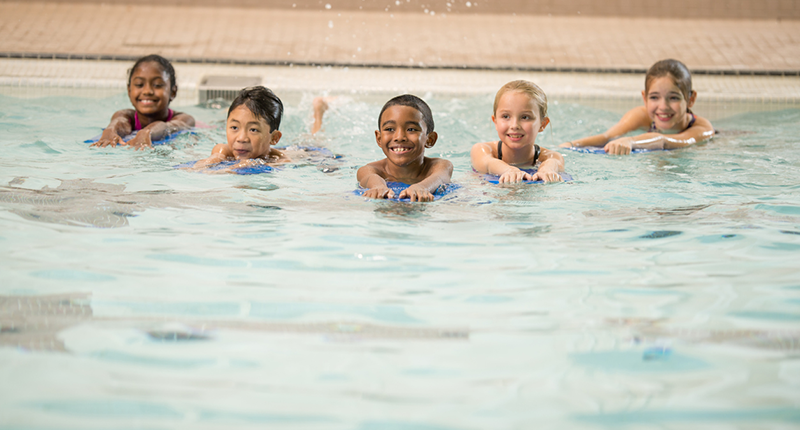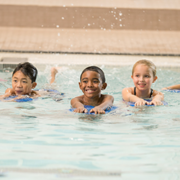The Importance of Physical Literacy in Different Environments

Physical literacy—the ability to move competently and confidently in various physical activities—lays the foundation for a lifetime of active, healthy living. By developing physical literacy across indoor and outdoor land, water, air, and snow and ice, individuals gain the skills, motivation, and understanding to safely and confidently explore a wide range of activities. These environments not only support diverse sports and activity participation but also equip individuals with tools to navigate potential risks throughout their lives.
The Value of Physical Literacy Across Environments
Natural Outdoor Environments
Spending time outdoors offers unique opportunities to develop physical literacy while fostering a love for movement. Research consistently shows that children who engage with natural spaces experience both physical and mental health benefits. For example, the 2018 ParticipACTION Report Card on Physical Activity for Children and Youth highlights the role of school amenities like green spaces and playfields in promoting physical activity. These spaces encourage movement and exploration, vital for children’s development and long-term physical literacy (ParticipACTION, 2018).
Engaging in activities such as hiking, climbing, or orienteering helps develop fundamental movement skills, including balance, agility, and coordination. These skills are further refined through the dynamic conditions presented by natural environments, such as navigating uneven terrain, varying weather, and changing light levels. Additionally, the Children & Nature Network emphasizes that outdoor play enhances cognitive development, improving problem-solving skills and encouraging resilience (Children & Nature Network, 2020).
Key Benefits
- Physical Development: Movement in natural settings strengthens core skills such as balance and agility while improving cardiovascular health.
- Mental and Emotional Growth: Outdoor play reduces stress, enhances mood, and builds confidence. The challenges of risky play, like climbing or jumping across streams, also encourage self-reliance (Harvard Medical School, 2018).
- Connection to Nature: Activities in green spaces promote a lifelong appreciation for the environment, contributing to a sense of well-being and environmental stewardship (Children & Nature Network, 2020).
Natural outdoor environments provide a rich foundation for physical literacy development, combining physical activity, cognitive challenges, and emotional growth. Encouraging exploration in these spaces ensures that individuals not only stay active but also build lifelong skills and confidence.
Aquatic Environments
As shown in the resource “Physical Literacy in Aquatic Environments: A Discussion Paper” (Sport for Life, 2019), physical literacy in aquatic environments requires a holistic approach encompassing four essential learning domains: psychomotor (movement skills), cognitive (understanding and decision-making), affective (confidence and motivation), and social (collaboration and safety awareness). According to the World Health Organization’s latest data (2023), drowning remains a critical global health concern, causing over 236,000 deaths annually, with more than 90% of these fatalities occurring in low- and middle-income countries. This emphasizes the urgent need for effective and accessible water safety programs that address all aspects of aquatic competency.
Developing aquatic literacy transcends traditional swimming instruction through an integrated approach. Research by Brenner et al. (2006) shows that programs combining competence building, risk management education, and social support networks reduce drowning incidents by fostering what they describe as “community water competence.” While swimming ability is fundamental, it must be complemented by environmental awareness, risk assessment skills, and collective responsibility for safety” (Brenner et al., 2006).
Key Benefits
- Enhanced Safety: Water safety skills, combined with swimming proficiency, significantly reduce the risk of drowning.
- Lifelong Participation: Aquatic literacy enables engagement in diverse activities like kayaking, snorkelling, and water polo.
- Economic Impact: Canada faces $173 million in annual costs from drowning-related injuries and fatalities, underlining the value of prevention initiatives (World Health Organization, 2014).
Developing physical literacy in aquatic environments requires a holistic approach encompassing swimming skills, safety education, and inclusive community programs. As outlined in Sport for Life’s blog, Swimming Ability Alone Isn’t Enough, fostering collective competence and addressing barriers to participation are essential for creating safer, more inclusive aquatic experiences (Sport for Life, 2023).
Aerial Environments
Aerial environments, such as those encountered in climbing, gymnastics, or trampoline activities, provide unique opportunities to develop physical literacy. These activities enhance core movement skills, including balance, spatial awareness, and agility, which are foundational for pursuits such as parkour, BMX biking, and aerial acrobatics.
Key Benefits
- Physical and Mental Resilience:
Aerial activities promote physical strength, flexibility, and coordination while fostering confidence and problem-solving abilities. A report by Active Healthy Kids Canada highlights that gymnastics and similar aerial sports significantly improve spatial awareness and motor skills, laying a strong foundation for lifelong physical literacy. - Creativity and Adaptability:
Engaging in aerial environments challenges participants to navigate dynamic movements and obstacles, encouraging innovative problem-solving and adaptability. - Lifelong Engagement:
Aerial activities provide a sense of accomplishment that motivates continued participation. According to the European Journal of Sport Science, individuals who engage in aerial sports often transition to other complex activities later in life, such as skiing or mountain biking.
Aerial environments offer unique and dynamic opportunities to build physical literacy while promoting creativity, confidence, and adaptability. By emphasizing proper safety measures, gradual progression, and professional supervision, these activities can be safely enjoyed across all ages, inspiring a lifelong engagement with movement and adventure.
Snow and Ice Environments
Navigating snow and ice is often a daily necessity for individuals in winter climates. Developing physical literacy in these environments not only reduces the risk of injuries, such as slips and falls on icy surfaces, but also opens the door to a range of recreational and competitive activities, from skating to skiing.
Key Benefits
- Improved Safety and Injury Prevention:
Falls on icy sidewalks and driveways are a leading cause of winter injuries. Data from ParticipACTION shows that participation in winter sports improves balance and coordination, reducing fall risk among older adults by up to 30%. Building these skills early and maintaining them over time ensures individuals can confidently navigate snowy and icy conditions throughout life. - Lifelong Physical Engagement:
Activities such as skating, snowshoeing, and skiing foster agility, balance, and endurance. These skills not only support mobility but also enhance confidence, enabling people to stay active and socially connected during the winter months. - Mental and Emotional Well-Being:
Engaging in winter activities provides mental health benefits by reducing stress and fostering a sense of achievement. Research from the Journal of Environmental Psychology has also shown that exposure to natural winter environments improves mood and overall well-being.
Snow and ice environments provide unique opportunities to build physical literacy while supporting safety, mobility, and confidence. By developing foundational skills and emphasizing proper preparation, individuals can enjoy a wide range of winter activities across their lifespan, making even the harshest seasons a time for growth and exploration.
Conclusion
Developing physical literacy across diverse environments is essential for lifelong health, safety, and activity. By fostering these skills early, individuals gain the confidence to explore new activities, the competence to avoid risks, and the motivation to lead an active lifestyle.
Coaches, educators, and parents play a pivotal role by encouraging movement in all environments, creating opportunities for structured and unstructured play, and promoting enjoyment alongside skill development. To support this mission, Sport for Life offers valuable resources and programs designed to help individuals and communities build physical literacy.
For further insights and practical guidance, explore these key resources:
- Developing Physical Literacy: Building a New Normal for All Canadians
- Physical Literacy in Aquatic Environments: A Discussion Paper
By leveraging these tools and fostering physical literacy across all environments, we ensure individuals are not only safer but also more connected to the world around them, unlocking their full potential for lifelong participation in physical activity.
References
Children & Nature Network. (n.d.). Learning Outside. Retrieved from https://www.childrenandnature.org/schools/learning-outside
World Health Organization. (2014). Global report on drowning: preventing a leading killer. Retrieved from https://www.who.int/publications/i/item/global-report-on-drowning-preventing-a-leading-killer
Sport for Life. (2019). Physical Literacy in Aquatic Environments: A Discussion Paper. Retrieved from https://sportforlife.ca/portfolio-item/physical-literacy-in-aquatic-environments-a-discussion-paper
Harvard Health Publishing. (2018). 6 reasons children need to play outside. Retrieved from https://www.health.harvard.edu/blog/6-reasons-children-need-to-play-outside-2018052213880
ParticipACTION. (2023). 2024 Children and Youth Report Card. Retrieved from https://www.participaction.com/the-science/children-and-youth-report-card

